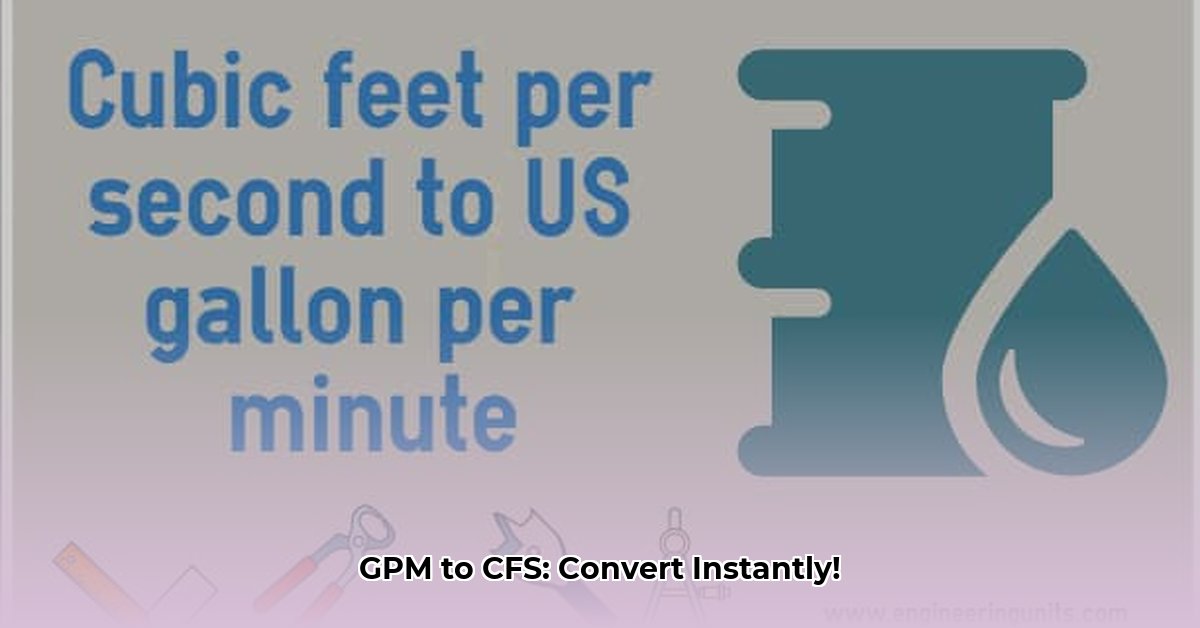Introduction: Measuring the Flow
Understanding how water moves, whether it’s a trickle from a faucet or the rush of a river, is crucial in many fields. We often measure this flow in gallons per minute (GPM) for smaller systems and cubic feet per second (CFS) for larger ones. This guide provides a clear, step-by-step explanation of how to convert between these two units, equipping you with the tools and knowledge you need.
Understanding GPM and CFS
Think of your kitchen faucet. The flow of water coming out can likely be measured in gallons per minute (GPM). GPM measures volume over a short time, ideal for household appliances or smaller systems. Now, picture a rushing river. For larger-scale flows, we use cubic feet per second (CFS). CFS tells us how much water, in terms of volume (cubic feet), passes a specific point every second. So, GPM is like a small measuring cup, while CFS is like a giant bucket.
Converting GPM to CFS: The Formula
The conversion from GPM to CFS relies on the constant 0.002228. Simply multiply your GPM value by this factor:
CFS = GPM * 0.002228
Example: GPM to CFS
Let’s say a pump moves water at 250 GPM. How much is that in CFS?
CFS = 250 GPM * 0.002228 = 0.557 CFS
Therefore, 250 GPM is equivalent to 0.557 CFS.
Converting CFS to GPM: The Reverse
To convert from CFS back to GPM, multiply your CFS value by 448.831:
GPM = CFS * 448.831
Example: CFS to GPM
A river flows at 1.5 CFS. How many GPM is this?
GPM = 1.5 CFS * 448.831 = 673.25 GPM (approximately)
So, 1.5 CFS is roughly equivalent to 673.25 GPM.
GPM to CFS Conversion Table
| GPM | CFS |
|---|---|
| 1 | 0.0022 |
| 5 | 0.0111 |
| 10 | 0.0223 |
| 50 | 0.1114 |
| 100 | 0.2228 |
| 250 | 0.557 |
| 500 | 1.114 |
| 1000 | 2.228 |
| 2000 | 4.456 |
| 5000 | 11.14 |
| 10000 | 22.28 |
Interactive Calculator (Conceptual – Implementation Needed)
(This section would ideally contain an embedded interactive calculator where users can input GPM and instantly receive the CFS equivalent. This is a key element for user engagement and practicality.) For now, you can use the formula provided above.
Real-World Applications
Converting between GPM and CFS is vital in various fields:
- Irrigation: Matching water source flow rates to crop needs.
- Plumbing: Sizing pipes and ensuring appropriate water pressure.
- Hydrology: Studying river flows and predicting floods.
- HVAC Systems Design: Calculating optimal flow rates for heating and cooling systems.
- Industrial Processes: Precise flow control in manufacturing and other applications.
US Gallons vs. UK Gallons
Remember, these calculations use US gallons. UK gallons are different, so always clarify which unit you’re using. This small detail can significantly impact your results. While the US gallon is most commonly used in these applications, discrepancies can arise, particularly in international collaborations. Some research suggests these historical differences may have influenced measurement standards used today.
Calculating Flow Velocity in Pipes
Flow rate (GPM or CFS) tells us the volume of water moving, but velocity tells us how fast it’s moving within a pipe. Velocity is measured in feet per second (FPS).
To calculate velocity, we need the pipe’s radius (r in feet):
FPS = (GPM * 0.002228) / (π * r²)
For example, if 20 GPM flows through a pipe with a 6-inch diameter (radius = 0.25 feet):
FPS = (20 * 0.002228) / (π * 0.25²) ≈ 2.27 FPS
The Bigger Picture: Beyond the Numbers
Understanding flow rates is more than just converting units; it’s about grasping how water shapes our world. From the efficiency of irrigation systems to the health of aquatic ecosystems, flow rates play a crucial role. Further research continues to explore the complexities of fluid dynamics and its impact on various aspects of our lives. Some theories suggest a more nuanced understanding of flow patterns may lead to more sustainable water management practices in the future. While our current models are effective, ongoing research reminds us that our understanding is continually evolving.
FAQ (Optional – Placeholder for Future Expansion)
This section can be expanded to address frequently asked questions about GPM to CFS conversions, further enhancing the guide’s value as a comprehensive resource.
- How Did Charles F. Brush Discover Wind Energy Tech? - November 19, 2025
- Wind Energy Vertical: Weighing the Pros and Cons of Wind Power - November 16, 2025
- How Much Energy Does a Wind Turbine Actually Create? - November 14, 2025
















